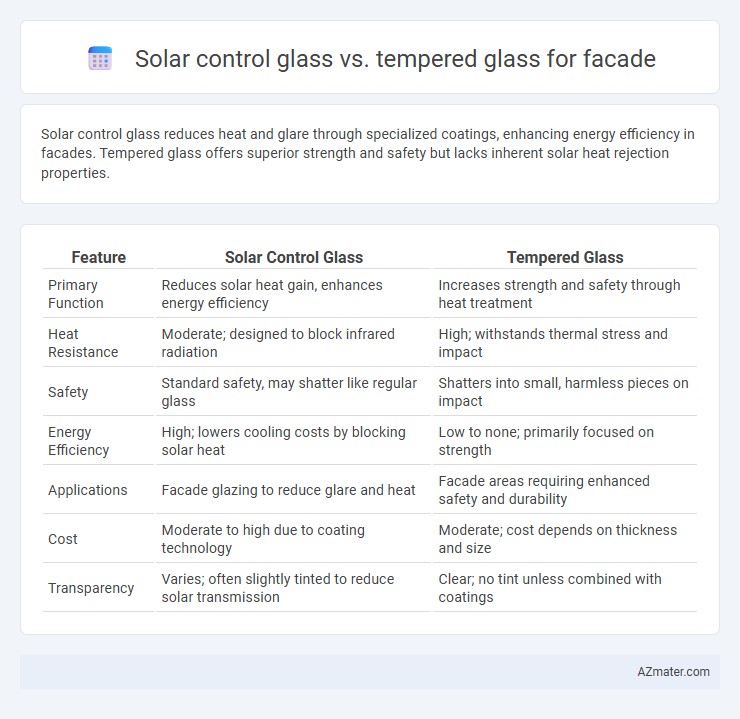Solar control glass reduces heat and glare through specialized coatings, enhancing energy efficiency in facades. Tempered glass offers superior strength and safety but lacks inherent solar heat rejection properties.
Table of Comparison
| Feature | Solar Control Glass | Tempered Glass |
|---|---|---|
| Primary Function | Reduces solar heat gain, enhances energy efficiency | Increases strength and safety through heat treatment |
| Heat Resistance | Moderate; designed to block infrared radiation | High; withstands thermal stress and impact |
| Safety | Standard safety, may shatter like regular glass | Shatters into small, harmless pieces on impact |
| Energy Efficiency | High; lowers cooling costs by blocking solar heat | Low to none; primarily focused on strength |
| Applications | Facade glazing to reduce glare and heat | Facade areas requiring enhanced safety and durability |
| Cost | Moderate to high due to coating technology | Moderate; cost depends on thickness and size |
| Transparency | Varies; often slightly tinted to reduce solar transmission | Clear; no tint unless combined with coatings |
Introduction to Solar Control Glass and Tempered Glass
Solar control glass is designed to reduce heat gain and minimize ultraviolet (UV) radiation while maintaining natural light transmission, making it ideal for energy-efficient building facades. Tempered glass, also known as toughened glass, undergoes a heat treatment process that increases its strength and ensures safety by shattering into small, blunt pieces upon impact. The choice between solar control glass and tempered glass depends on balancing energy performance with structural safety requirements for facade applications.
Key Properties and Composition
Solar control glass incorporates a special coating that reflects solar radiation, significantly reducing heat gain while maintaining high visible light transmission, making it ideal for energy-efficient facades. Tempered glass is chemically or heat-treated to enhance mechanical strength and safety by shattering into small, blunt pieces upon breakage, but it lacks significant solar heat rejection properties. The primary composition difference lies in solar control glass featuring low-emissivity or reflective coatings on standard annealed glass, whereas tempered glass is essentially heat-strengthened soda-lime glass without added functional coatings.
Energy Efficiency and Thermal Performance
Solar control glass significantly enhances energy efficiency in facades by reflecting and absorbing a substantial portion of solar radiation, reducing heat gain and lowering cooling costs. Tempered glass offers superior mechanical strength and thermal resistance but lacks the advanced coatings that improve solar heat rejection. Combining solar control coatings with tempered glass provides optimal thermal performance and durability for sustainable building envelopes.
Light Transmission and Glare Reduction
Solar control glass for facades offers superior glare reduction by filtering infrared and ultraviolet rays while maintaining high light transmission, typically ranging between 40% to 70%. Tempered glass primarily provides enhanced strength and safety but does not inherently reduce glare or control solar heat, transmitting up to 89% of visible light. Choosing solar control glass optimizes facade performance by balancing natural daylight with effective solar heat gain management and glare minimization.
Safety and Strength Comparisons
Solar control glass enhances building safety by reducing heat transmission and glare, contributing to a more comfortable and secure interior environment, while tempered glass offers superior mechanical strength and shatter resistance due to its heat-treated manufacturing process. In facade applications, tempered glass provides higher impact resistance and breaks into small, less harmful pieces, significantly reducing injury risk during breakage compared to regular annealed glass. Solar control glass can be tempered for enhanced durability, combining thermal performance with the robust safety features of tempered glass, making it ideal for facades requiring both energy efficiency and high-strength safety standards.
Durability and Maintenance Requirements
Solar control glass offers enhanced durability due to its specialized coatings that resist scratching and weathering, making it ideal for facades exposed to harsh environmental conditions. Tempered glass provides exceptional strength through thermal or chemical treatment, improving resistance to impact and thermal stress, but lacks the energy efficiency benefits of solar control glass. Maintenance for solar control glass involves periodic cleaning to preserve coating effectiveness, while tempered glass requires minimal upkeep but may demand replacement if fractured.
Architectural Design Flexibility
Solar control glass offers superior architectural design flexibility by enabling precise control over heat gain and light transmission, which allows designers to create energy-efficient facades without compromising aesthetics. Tempered glass provides high strength and safety but lacks inherent solar control properties, often requiring additional coatings or films to manage solar heat. The integration of solar control technology in glass maximizes design options while enhancing building performance, making it a preferred choice for modern facades.
Cost Implications and Budget Considerations
Solar control glass typically incurs higher initial costs compared to tempered glass due to its specialized coating technology designed to reduce heat gain and improve energy efficiency in building facades. Tempered glass offers budget-friendly pricing but lacks the advanced thermal performance, which may lead to increased cooling expenses over time. Selecting solar control glass can result in long-term savings through reduced HVAC energy consumption, making it a cost-effective choice for projects prioritizing sustainability and operational budget efficiency.
Sustainability and Environmental Impact
Solar control glass enhances facade sustainability by significantly reducing solar heat gain, lowering cooling energy consumption and associated carbon emissions compared to standard tempered glass. Tempered glass offers strength and safety but lacks the energy efficiency benefits embedded in solar control coatings that reflect infrared and ultraviolet rays. Incorporating solar control glass in building facades promotes long-term environmental impact reduction through optimized daylight use and decreased reliance on HVAC systems.
Choosing the Right Glass for Facade Applications
Solar control glass enhances energy efficiency by reducing heat gain and glare, making it ideal for facades in hot climates or buildings prioritizing sustainability. Tempered glass offers superior strength and safety due to its impact resistance and shattering behavior, suitable for high-traffic or impact-prone facade areas. Selecting the right glass depends on balancing thermal performance and structural safety requirements specific to the facade's location and building design.

Infographic: Solar control glass vs Tempered glass for Facade
 azmater.com
azmater.com